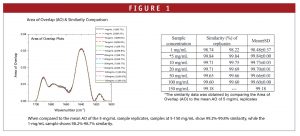Issue:March 2019
CHARACTERIZATION CORNER - From Dilute Sample to Clinically Representative Formulation: Analyzing the Higher Order Structure of mAbs Over a Wide Dynamic Range
 Maintaining the structural integrity of a biotherapeutic, up to the point of delivery, is essential to safeguard its safety and efficacy. During the biomanufacturing process, there is potential for proteins such as monoclonal antibodies (mAbs) to undergo conformational changes, which alter their secondary structure, leading to critical variations in functionality. The characterization of mAbs at high concentration (150 mg/mL), in clinically representative formulations, without the need for dilution, or concern for interference from a formulation buffer’s excipient, is therefore vital. Such analysis helps scientists to understand and control the impact of processing conditions on the structure of the drug product. On the other hand, earlier stages of drug development call for analysis at much lower concentrations in far simpler samples. The most common limitation of traditional analytical techniques for the characterization of protein structure is that they operate across a narrow concentration range, but an ability to robustly characterize structure in the presence of excipients can also be an issue.
Maintaining the structural integrity of a biotherapeutic, up to the point of delivery, is essential to safeguard its safety and efficacy. During the biomanufacturing process, there is potential for proteins such as monoclonal antibodies (mAbs) to undergo conformational changes, which alter their secondary structure, leading to critical variations in functionality. The characterization of mAbs at high concentration (150 mg/mL), in clinically representative formulations, without the need for dilution, or concern for interference from a formulation buffer’s excipient, is therefore vital. Such analysis helps scientists to understand and control the impact of processing conditions on the structure of the drug product. On the other hand, earlier stages of drug development call for analysis at much lower concentrations in far simpler samples. The most common limitation of traditional analytical techniques for the characterization of protein structure is that they operate across a narrow concentration range, but an ability to robustly characterize structure in the presence of excipients can also be an issue.
Biotherapeutics are typically delivered intravenously or subcutaneously in liquid formulations, often at relatively high concentrations to minimize administration time within the limitation of having a stable formulation of practical viscosity. Sample dilution complicates measurement as well as introducing an additional source of analytical variability, and the extrapolation of measured results to higher concentrations is widely recognized as a potential source of error in biopharmaceutical characterization because of the sensitivity of protein structure to its surrounding environment.
FTIR, although recognized for 50+ years as a powerful technique, is inherently disadvantaged for protein characterization due to its lack of dynamic range, weak optical source, and lack of automation limiting referencing techniques. Ultraviolet-circular dichroism (UVCD), in contrast, is an established tool for structural analysis at more dilute concentrations (typically operating in the range 0.2 to 2.0 mg/mL) but is unsuitable for direct measurement at high formulation concentrations and formulations containing interfering excipients.
We worked with Celldex to test Microfluidic Modulation Spectroscopy (MMS), against their conventional analytical tools for mABs analyses. MMS is a protein characterization technique that combines a microfluidic flow cell and a tunable mid-IR quantum cascade laser source to assess the stability, similarity, quantitation linearity, denaturation, and aggregation of proteins by analyzing the absorbance spectra and determining the higher order structures (HOS).
MMS uses a tunable mid-IR quantum cascade laser to generate an optical signal hundreds of times brighter than the conventional sources used in FTIR spectroscopy. Brighter sources also allow the use of simpler detectors without the need for liquid nitrogen cooling. Additionally, the sample (protein) solution and a matching buffer reference stream are automatically introduced into a microfluidic flow cell, and the two fluids are rapidly modulated (eg, 1 to 4 Hz) across the laser beam path to produce nearly drift-free background compensated measurements.
To evaluate the data quality and performance of MMS versus conventional mid-IR and far-UV -CD techniques, a mAb formulated at relatively high concentration, with a RedShiftBio AQS3TMpro MMS instrument at different concentrations from 1 mg/mL to 150 mg/mL.
The data shows that the differential absorbance spectra (diffAU) replicates for each sample are very closely matched, indicating high repeatability and accuracy of the MMS measurements. The maximum diffAU signal versus protein concentration data fits a straight line with an R2 value of 0.999, displaying exemplary quantitation linearity across the concentration range, from 1 mg/mL to 150 mg/mL. The absolute absorbance spectra (absAU) of the antibody samples at concentrations from 1 mg/mL to 150 mg/mL overlay very well, suggesting a common secondary structure profile of these samples. When comparing the Area of Overlap (AO) plots to the mean AO plot of the sample replicates, the similarity is greater than 98% across the entire concentration range.
A detailed HOS analysis yields consistent secondary structure estimations for these samples, ie, 59%-61% beta sheet structure, 28%-29% turn structure, and very small amounts of alpha-helix and unordered structures. No dilution of high concentration samples is required for MMS measurements, and there are no interferences from optically active components in formulation buffers. The results clearly demonstrate that MMS delivers accurate, highly reproducible protein characterization across a dynamic range far broader than can be accessed via conventional IR and CD techniques. Furthermore, they highlight the strength of MMS as a powerful technique for the characterization of HOS and comparability studies involving complex protein samples formulated with excipients.
Dynamic range is one of the biggest challenges we hear from formulation scientists when characterizing proteins with current techniques. Celldex and others have highlighted that a key advantage of MMS is its wide dynamic range. MMS can measure over many decades of concentration, from 0.1 to 200 mg/mL (down to 0.01 mg/mL for protein quantification applications), in contrast to the single decade of concentration measurement associated with alternative techniques for measurement of the secondary structure of proteins, such as FTIR and UV-CD. The ability to consistently measure at the concentration of interest from the early stages of biotherapeutic development through formulation into manufacture, with a single technique, with negligible requirements for sample dilution/concentration, is a major gain.
Future Characterization Corners columns will address challenges faced during the biophysical characterization of proteins.
Thank you to Ioannis A. Papayannopoulos and Shannon Renn-Bingham at Celldex Therapeutics, 151 Martine Street, Fall River, MA, 02723, for providing the data.

Jeff Zonderman
Chief Commercial Officer
RedShift BioAnalytics, Inc.
Total Page Views: 3480
















